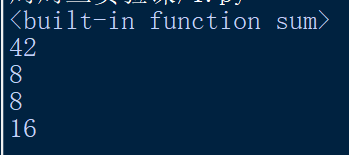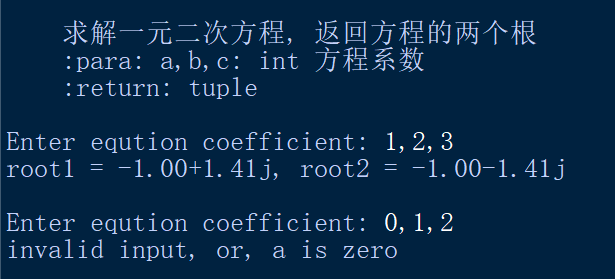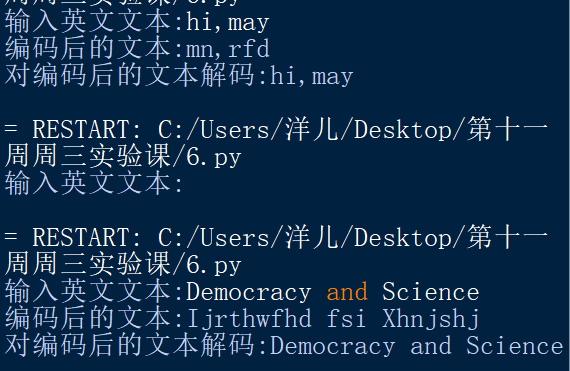实验四
一
1 print(sum) 2 sum = 42 3 print(sum) 4 5 def inc(n): 6 sum = n+1 7 print(sum) 8 return sum 9 sum = inc(7) + inc(7) 10 print(sum)

回答:
不是;line2,6是全局作用域,9是函数作用域
二
1 list1 = [1, 9, 8, 4] 2 3 print( sorted(list1) ) 4 print( sorted(list1, reverse=True) ) 5 print( sorted(list1, True) )

reverse需要参数传递
1 def func(a, b, c, /, *, d, e, f): 2 return( [a,b,c,d,e,f] ) 3 print(func(1,2,3,d=4,e=5,f=6))

三
1 def solve(a, b, c): 2 ''' 3 求解一元二次方程, 返回方程的两个根 4 :para: a,b,c: int 方程系数 5 :return: tuple 6 ''' 7 delta = b*b - 4*a*c 8 delta_sqrt = abs(delta)**0.5 9 p1 = -b/2/a; 10 p2 = delta_sqrt/2/a 11 if delta>=0: 12 root1 = p1 + p2 13 root2 = p1 - p2 14 else: 15 root1 = complex(p1, p2) 16 root2 = complex(p1, -p2) 17 return root1, root2 18 print(solve.__doc__) 19 while True: 20 try: 21 a,b,c = eval(input('Enter eqution coefficient: ')) 22 if a == 0: 23 raise 24 except: 25 print('invalid input, or, a is zero') 26 break 27 else: 28 root1, root2 = solve(a, b, c) 29 print(f'root1 = {root1:.2f}, root2 = {root2:.2f}') 30 print()


四
1 def list_generator(x,y,z=1): 2 list=[] 3 while x<=y: 4 list.append(x) 5 x+=z 6 return list 7 list1 = list_generator(-5, 5) 8 print(list1) 9 list2 = list_generator(-5, 5, 2) 10 print(list2) 11 list3 = list_generator(1, 5, 0.5) 12 print(list3)

五
1 from math import sqrt 2 def is_prime(x): 3 if x<2: 4 return False 5 else: 6 for i in range(2,int(sqrt(x)+1)): 7 if x%i==0: 8 return False 9 else: 10 return True 11 12 def gede(x): 13 for i in range(2,x): 14 h=x-i 15 if is_prime(h) and is_prime(i): 16 print(x,"=",i,"+",h) 17 return True 18 return False 19 i=4 20 while(gede(i) and i<20): 21 i+=2

六
1 def encoder(text): 2 a=[] 3 for i in text: 4 if 97<=ord(i.lower())<=117: 5 i=chr(ord(i)+5) 6 elif 118<=ord(i.lower())<=122: 7 i=chr(ord(i)-21) 8 a.append(i) 9 return ''.join(a) 10 def decoder(text): 11 a=[] 12 for i in text: 13 if 102<=ord(i.lower())<=122: 14 i=chr(ord(i)-5) 15 elif 97<=ord(i.lower())<=101: 16 i=chr(ord(i)+21) 17 a.append(i) 18 return ''.join(a) 19 a=input('输入英文文本:') 20 print(f'编码后的文本:{encoder(a)}\n对编码后的文本解码:{decoder(encoder(a))}')

七
1 def collatz(n): 2 if n%2==0: 3 return int(n/2) 4 else: 5 return int(n*3+1) 6 try: 7 l=[] 8 x=int(input('Enter a positive integer: ')) 9 l.append(x) 10 if x<=0: 11 raise 12 while True: 13 c=collatz(x) 14 l.append(c) 15 x=c 16 if x==1: 17 break 18 print(l) 19 except: 20 print('Error: must be a positive integer')

收获:
1,复习了字母大小写的转换方法,以及定义函数的调用
2,学会了处理程序报错的方法,并且耐心得到了锻炼


 浙公网安备 33010602011771号
浙公网安备 33010602011771号